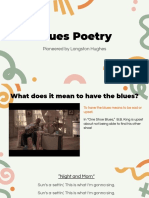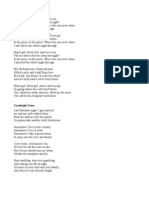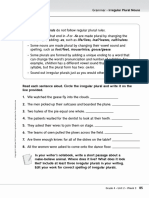The Blues and Langston Hughes
The Blues and Langston Hughes
Uploaded by
Maria SteriopolCopyright:
Available Formats
The Blues and Langston Hughes
The Blues and Langston Hughes
Uploaded by
Maria SteriopolOriginal Title
Copyright
Available Formats
Share this document
Did you find this document useful?
Is this content inappropriate?
Copyright:
Available Formats
The Blues and Langston Hughes
The Blues and Langston Hughes
Uploaded by
Maria SteriopolCopyright:
Available Formats
The Blues and Langston Hughes
What makes a poem sound pleasing to the ear? A solid rhythm for one thing—something we
know a good song also depends on. There are two poetic forms that began as song forms:
the ballad stanza of British and American literature and the blues stanzas of Harlem Renaissance
poet Langston Hughes.
Blues in Poetry
A recognizable song structure in popular music is the African American blues stanza. The
intention of the lyrics is to express an emotion. The blues rhythm originated in African American
field hollers and work songs, and some trace it to centuries-old songs by griots [storytellers] of
West Africa. Here is a stanza from Lead Belly’s ”Good Morning Blues”:
Good morning blues. How do you do?
Good morning blues. How do you do?
I’m doing all right. Good morning. How are you?
There are generally three lines in the blues stanza – the second line repeats the first, and the third
line brings home the rhyme. The lyrics are usually set to twelve bars of music in 4/4 time. While
the lyrics of the blues are rarely in a structured meter, the music often has a driving beat that is
not unlike the heartbeat rhythm.
The first to recognize the potential of the blues as written poetry was Langston Hughes, who was
born in Joplin, Missouri, in 1902. When he was eleven years old, he heard the blues coming from
an orchestra of blind musicians on Independence Avenue in Kansas City. Hughes moved to the
East Coast in 1921 and heard the music again, in clubs on Lenox Avenue in Harlem, New York,
and 7th Street in Washington, D.C. “I tried to write poems like the songs they sang on 7th
Street,” he remembered in his autobiography The Big Sea. Those songs “had the pulse beat of the
people who keep on going.” The blues stanza allowed Hughes to convey the African American
experience in people’s own vernacular language.
The song structure of the blues seems to have originated in the Mississippi Delta in the late
nineteenth century. The term the blues, as in “having the blues,” comes from a centuries-old term
for a state of melancholy. Blues lyrics usually tell of some trouble, but often in a comical way.
The “blues stanza” became a standard lyric in popular music. It is composed of three lines: the
second line repeats the first; the third line rhymes. Here, for example, is a stanza from “Green
River Blues” by the Delta musician Charley Patton:
Some people say the Green River blues ain’t bad.
Some people say the Green River blues ain’t bad.
Then it must-a not been the Green River blues I had.
Here is a seminal bit of blues-based rock and roll:
You ain’t nothin’ but a hound dog, cryin’ all the time.
You ain’t nothin’ but a hound dog, cryin’ all the time.
You ain’t never caught a rabbit and you ain’t no friend of mine.
Source: Smithsonian Institution: http://www.folkways.si.edu/explore_folkways/poetry.aspx
Langston Hughes’ biographer describes the poet’s early
description of the blues in this quote, “The music seemed to
cry, but the words somehow laughed,” as in “Morning After.”
I said, Baby! Baby!
Please don’t snore so loud.
Baby! Please!
Please don’t snore so loud.
You jest a little bit o’ woman but you
Sound like a great big crowd.
When writing in the blues form, Hughes broke the three lines of each stanza into six lines, as
demonstrated in the stanzas from the poem “Homesick Blues”:
De railroad bridge’s Homesick blues, Lawd,
A sad song in de air. ‘S a terrible thing to have.
De railroad bridge’s Homesick blues is
A sad song in de air. A terrible thing to have.
Ever time de train pass To keep from cryin’
I wants to go somewhere. I opens ma mouth an’ laughs.
I went down to the station.
My heart was in ma mouth.
Went down to the station.
Heart was in ma mouth.
Lookin’for a box car
To roll me to de South.
The line breaks give a further sense of the music, indicating where a singer might pause or drag a
word across a few beats.
“Night and Morn”
Sun’s a-settin’, Sun’s a-risin’,
This is what I’m gonna sing. This is gonna be ma song,
Sun’s a settin’, Sun’s a risin’,
This is what I’m gonna sing: This is gonna be ma song,
I feels de blues a comin’, I could be blue but
Wonder what de blues’ll bring? I been blue all night long.
African-American writer Ralph Ellison said that although the blues are often about struggle and
depression, they are also full of determination to overcome difficulty “through sheer toughness
of spirit.” This resilience in the face of hardship is one of the hallmarks of the blues poem.
You might also like
- A First Book of Blues: For The Beginning PianistFrom EverandA First Book of Blues: For The Beginning PianistRating: 5 out of 5 stars5/5 (2)
- Old Plantation Hymns A Collection of Hitherto Unpublished Melodies of The Slave and The Freedman, W - Barton, William Eleazar, 1861-1930Document61 pagesOld Plantation Hymns A Collection of Hitherto Unpublished Melodies of The Slave and The Freedman, W - Barton, William Eleazar, 1861-1930jkbisnisNo ratings yet
- Poetry PPT Poetry Techniques/Poetic DevicesDocument15 pagesPoetry PPT Poetry Techniques/Poetic DevicestheenglishteacherireNo ratings yet
- Sorensen Self-Esteem TestDocument2 pagesSorensen Self-Esteem TestIuliaPopescuNo ratings yet
- Department of Civil Engineering, VVIET, MysoreDocument60 pagesDepartment of Civil Engineering, VVIET, Mysoredinesh_sshiva91% (11)
- New Highway: Selected Lyrics, Poems, Prose, Essays, Eulogies and BluesFrom EverandNew Highway: Selected Lyrics, Poems, Prose, Essays, Eulogies and BluesNo ratings yet
- Riversongs PresentationDocument11 pagesRiversongs Presentationapi-240855268No ratings yet
- BluesDocument5 pagesBluesbabalwafanayo14No ratings yet
- Blues PoetryDocument16 pagesBlues Poetryapi-383621302No ratings yet
- Langston Hughes PoetryDocument13 pagesLangston Hughes PoetryVaani DhyaniNo ratings yet
- "The Weary Blues" Is One of 'S "Blues" PoemsDocument2 pages"The Weary Blues" Is One of 'S "Blues" PoemsSONANo ratings yet
- Poems Breakdown For SeanDocument20 pagesPoems Breakdown For Seanzaferismailasvat1786No ratings yet
- Bonnie Apis - Poem Analysis Ballads Due Thursday at End of ClassDocument2 pagesBonnie Apis - Poem Analysis Ballads Due Thursday at End of Classapi-452150993No ratings yet
- Soonahwillbedone AnitaahamefulaDocument3 pagesSoonahwillbedone Anitaahamefulaapi-351675451No ratings yet
- NWL Essay 2012Document3 pagesNWL Essay 2012jmik76No ratings yet
- Langston HughesDocument6 pagesLangston HughesNamahill razaNo ratings yet
- Blues Music.Document14 pagesBlues Music.Lisa LisaLisa100% (1)
- Eng Lit Notes PoemsDocument58 pagesEng Lit Notes Poemseduv4961194No ratings yet
- The Solitary ReaperDocument5 pagesThe Solitary ReaperaliNo ratings yet
- Solitary ReaperDocument9 pagesSolitary ReaperEverything ChannelNo ratings yet
- How To Write A Blues SongDocument2 pagesHow To Write A Blues Songapi-254928507No ratings yet
- Refrain Definition.2Document5 pagesRefrain Definition.2Adlian Kamilan SyakuraNo ratings yet
- Grade 9 Funernal Blues Wkst-3Document6 pagesGrade 9 Funernal Blues Wkst-3Aarya ModiNo ratings yet
- William WordsworthDocument12 pagesWilliam WordsworthnanaNo ratings yet
- The Weary BluesDocument14 pagesThe Weary BlueshebatullahmagdyNo ratings yet
- Daybreak in AlabamaDocument10 pagesDaybreak in AlabamaPaing Khant KyawNo ratings yet
- Mississippi Guitarist and Singer J.D. SuggsDocument39 pagesMississippi Guitarist and Singer J.D. SuggsDave van Bladel100% (1)
- Types of Lyric PoetryDocument5 pagesTypes of Lyric PoetryAllysa Maliwanag100% (1)
- ShenandoahDocument15 pagesShenandoahvalNo ratings yet
- Down in The Valley Research PaperDocument18 pagesDown in The Valley Research PaperAnnie McCuneNo ratings yet
- Analysis Song For A Dark Girl Poetry ClassDocument4 pagesAnalysis Song For A Dark Girl Poetry Classkimmy730No ratings yet
- Funeral Blues 8Document5 pagesFuneral Blues 8Thesandu heshanjanaNo ratings yet
- The Negro Speaks of Rivers by Langston Hughes..Document11 pagesThe Negro Speaks of Rivers by Langston Hughes..Mousumi MullickNo ratings yet
- Blues Roots MississippiDocument10 pagesBlues Roots Mississippijaksach80% (5)
- Siycwinter 06Document16 pagesSiycwinter 06marctoubonNo ratings yet
- Langston Hughes EssayDocument3 pagesLangston Hughes EssaySimone HojabriNo ratings yet
- Analysis - Not Waving But DrowningDocument7 pagesAnalysis - Not Waving But DrowningDespina KalaitzidouNo ratings yet
- Funeral BluesDocument3 pagesFuneral BluesjelenicajNo ratings yet
- Show Boat AnalysisDocument3 pagesShow Boat AnalysisJenny Jiou0% (1)
- What Is A SongDocument6 pagesWhat Is A SongNi Kadek Shinta Swandari 31No ratings yet
- The Solitary Reaper AnalysisDocument4 pagesThe Solitary Reaper AnalysisishirhanulNo ratings yet
- Negro Blues SingersDocument4 pagesNegro Blues SingersAnonymous FHCJucNo ratings yet
- Week 1 Playlist With Commentary Run 2Document4 pagesWeek 1 Playlist With Commentary Run 2Ewin ChenNo ratings yet
- The Negro Speaks of Rivers - AnalysisDocument10 pagesThe Negro Speaks of Rivers - Analysismuhammadayaanhussain18No ratings yet
- In The PinesDocument7 pagesIn The PineslolaNo ratings yet
- Literacy and Authenticity HughesDocument17 pagesLiteracy and Authenticity HughesMichaelJamesChristopherConklinNo ratings yet
- Composition II JAZZ NOTESDocument6 pagesComposition II JAZZ NOTESBilalNo ratings yet
- LitCharts The Weary BluesDocument14 pagesLitCharts The Weary BlueshltmtomliNo ratings yet
- Langston HugesDocument5 pagesLangston HugesRania MohammedNo ratings yet
- As I Walked Out One Evening AnalysisDocument3 pagesAs I Walked Out One Evening AnalysisZarsa Barda100% (2)
- Funeral Blues by W. H. AudenDocument42 pagesFuneral Blues by W. H. AudenEmile Armanious100% (1)
- Famous Poem by Langston HughesDocument19 pagesFamous Poem by Langston HughesVaishnavi BhosaleNo ratings yet
- Winter Lullaby AnalysisDocument3 pagesWinter Lullaby Analysisapi-385806603No ratings yet
- 2.the Piano-D.h.lawrence-1Document20 pages2.the Piano-D.h.lawrence-1Maa TherNo ratings yet
- We Real Cool by Gwendolyn Brooks: The Pool Players. Seven at The Golden ShovelDocument6 pagesWe Real Cool by Gwendolyn Brooks: The Pool Players. Seven at The Golden ShovelBianca Nicole CesistaNo ratings yet
- The Solitary ReaperDocument6 pagesThe Solitary ReaperAflah Fathima100% (1)
- Black Country Music: Listening for RevolutionsFrom EverandBlack Country Music: Listening for RevolutionsRating: 4 out of 5 stars4/5 (13)
- Harlem Renaissance PresentationDocument24 pagesHarlem Renaissance PresentationEBNo ratings yet
- Famous Blue Raincoat EnglishDocument11 pagesFamous Blue Raincoat EnglishAlbert FuentesNo ratings yet
- Gull One 2000Document15 pagesGull One 2000Maria SteriopolNo ratings yet
- Gmelch, Kemper, Zenner - Urban Life PDFDocument220 pagesGmelch, Kemper, Zenner - Urban Life PDFJm VictorianoNo ratings yet
- ComunicareDocument552 pagesComunicareMaria Steriopol100% (1)
- Design and Implementation of 2bit Vedic Multiplier at 16nm Using PTL LogicDocument5 pagesDesign and Implementation of 2bit Vedic Multiplier at 16nm Using PTL LogicKshitij SharmaNo ratings yet
- The Legal Aspects of Purchasing PowerpointDocument13 pagesThe Legal Aspects of Purchasing PowerpointMichael Zuniga100% (2)
- St. Peters Burg in Your Pocket, Feb-Mar 2012Document68 pagesSt. Peters Burg in Your Pocket, Feb-Mar 2012jedudley55No ratings yet
- Practical Inorganic ChemistryDocument13 pagesPractical Inorganic ChemistrymuanesabrahemNo ratings yet
- PFRS 14Document14 pagesPFRS 14Princess Jullyn ClaudioNo ratings yet
- VOD ConferenceDocument15 pagesVOD ConferenceCARLOS OSIEL SEBASTIÁN VALDÉSNo ratings yet
- LY IR 6000 V.3 BGA Rework Station: Can Be Connected To A Computer It Can Easily Rework The Variety of CPU's SeatDocument7 pagesLY IR 6000 V.3 BGA Rework Station: Can Be Connected To A Computer It Can Easily Rework The Variety of CPU's SeatMuhammad MajidNo ratings yet
- Business Profile (JAO-REN)Document15 pagesBusiness Profile (JAO-REN)Michael T. SebullenNo ratings yet
- Product KeysDocument2 pagesProduct KeysHorizon 99100% (1)
- Paw PatrolDocument4 pagesPaw PatrolMarisa Becker100% (1)
- Kendriya Vidyalaya Sangathan: Chennai RegionDocument281 pagesKendriya Vidyalaya Sangathan: Chennai RegionAshray EapurNo ratings yet
- 1 G.R. No. L-47822 December 22, 1988 Pedro de Guzman v. CADocument4 pages1 G.R. No. L-47822 December 22, 1988 Pedro de Guzman v. CArodolfoverdidajrNo ratings yet
- Difference Between Cambomba and HornwortDocument3 pagesDifference Between Cambomba and Hornwortador kumar0% (1)
- IBT Business PlanDocument11 pagesIBT Business PlanJonahNo ratings yet
- BSM370 EngDocument4 pagesBSM370 Engrizal maulanaNo ratings yet
- Chap 007Document16 pagesChap 007Ela PelariNo ratings yet
- BUS301 Business Law Unit Guide - UEHT3 2023 - DR Duy DinhDocument9 pagesBUS301 Business Law Unit Guide - UEHT3 2023 - DR Duy DinhNguyễn Việt Thi 12NC -No ratings yet
- Mae Tagarao Resume 2023Document1 pageMae Tagarao Resume 2023Mae TagaraoNo ratings yet
- Ch02P6 Gate DelaysDocument10 pagesCh02P6 Gate Delaysخالد الروميNo ratings yet
- Exam 2Document6 pagesExam 2María Belkis Rozo MeloNo ratings yet
- DIN 635 EN-1987 Single-Row Self-Aligning Roller BearingsDocument3 pagesDIN 635 EN-1987 Single-Row Self-Aligning Roller BearingsthachpnNo ratings yet
- 009a - Numerical Questions On MPC, MPS, APC, APS, Multiplier, Aggregate Demand, Aggregate Supply, Equilibrium Level of Income and Govt. BudgetDocument14 pages009a - Numerical Questions On MPC, MPS, APC, APS, Multiplier, Aggregate Demand, Aggregate Supply, Equilibrium Level of Income and Govt. BudgetAditya ShrivastavaNo ratings yet
- How Long It Takes To Change Your Life - Nwal Hadaki - TEDxSafirSchool - YouTube - EnglishDocument6 pagesHow Long It Takes To Change Your Life - Nwal Hadaki - TEDxSafirSchool - YouTube - Englishmohammad.mobashir.faisalNo ratings yet
- 4 TH Grade GrammarDocument14 pages4 TH Grade GrammarhazelbelendiazNo ratings yet
- CAEEM Impl ENUDocument79 pagesCAEEM Impl ENUdavor.dimeskiNo ratings yet
- Flute Self Help BookDocument5 pagesFlute Self Help BookEmerald Education FoundationNo ratings yet
- Limitations of Object Arrays: Collection Framework in JavaDocument18 pagesLimitations of Object Arrays: Collection Framework in JavaVenDettaNo ratings yet
- Republic Act No. 11917 PrintDocument1 pageRepublic Act No. 11917 PrintclusteradtmailNo ratings yet
- National Rural Livelihood Mission: Suggestions For Effective Design and ImplementationDocument7 pagesNational Rural Livelihood Mission: Suggestions For Effective Design and Implementationsonal_bhat_1No ratings yet





























































































